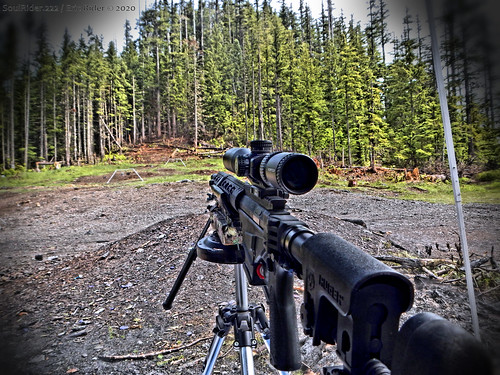Both optics are exceptionally well made and come in at a great price, but which brings more to the table? Which is more affordable? And which is better for you? Well, let’s dive in and take a look at what both companies have to offer.
Then you’ll know who’ll win in the Battle of Burris Fullfield II vs Vortex Diamondback!
Burris Fullfield II vs Vortex Diamondback Round 1: 3-9X40 Models
You may be asking me, why 3-9X40? Well, the reason I chose that over the other half configurations is that it’s one of the most common and well-revered magnification ranges out there. It’s perfect for both short-range shooting and long-range shooting, and size-wise they are compact and lightweight. Both Vortex and Burris offer 3-9X40 models in their Fullfield and Diamondback lines.
The Fullfield model is slightly cheaper but not majorly so. These is, however, enough difference to make it notable (though price fluctuations do happen). Both optics offer a longer eye relief of a bit more than 3 inches, which is perfect for full-powered, harder-recoiling calibers. As far as weight and overall size, the Fullfield is just slightly lighter, but the Diamondback is shorter. We are only talking an inch and an ounce, so the difference is minor.
One interesting difference is that the Diamondback offers a wider field of view than the Fullfield at both three power and nine power. This little difference is a sharp advantage in the world of riflescopes.
Another difference is their reticles. The Fullfield offers a traditional plex reticle and the Burris Ballistic Plex reticle that allows for elevation compensation. The Diamondback only offers the Diamondback Dead-Hold reticle, which offers aiming points for both elevation and wind compensation. The Dead-Hold is the more versatile reticle, but if wind and more extreme distances aren’t an issue, the Burris options will serve you well.
The Diamondback has turrets that are easier to adjust and better overall. The Diamondback has adjustable fingertip turrets that are capped to maximize protection. They can also be reset to zero, and this allows you to make on the fly modifications based on your original zero. The Burris Fullfield 2 has simple capped hunter turrets that require a piece of brass or small tool to make adjustments. There is nothing inherently wrong with these turrets, but they are harder to adjust in the field.
The Diamondback does offer a few advantages over the Fullfield 2, but it comes with a (generally) little extra price tag, so you’ll have to weigh your needs versus your budget.
Burris Fullfield II vs Vortex Diamondback Round 2: Long-Range Models
The Fullfield 2 and Diamondback come in various sizes, so let’s look at two of the models aimed at longer range shooting. The Burris Fullfield 2 has a model with a magnification range of 4.5-14X42, and the Vortex Diamondback comes in a 4-12X40 model. The Fullfield 2 does offer both more magnification and a slightly larger objective lens.
You may not need the extra magnification, but if you want to go far, you might want to go big. The extra magnification predictably means the optic is longer and heavier. The Diamondback is an inch shorter and weighs 3.4 ounces less than the Fullfield 2.
The Diamondback’s shorter magnification also results in a much wider field of view. The Diamondback gives you a 32.4 to 11-foot field of view at 100 yards. The Burris Fullfield 2 gives a 22 to 7.5-foot field of view at 100 yards.
The Diamondback also offers a fast focus eye box. This means it’s quicker to get your eye behind the optic in such a way that you can see the reticle and the target. It will be quicker to get a shot off with.
Reticle wise both offer an option with ballistic drop reticles. The Vortex model has the Dead-Hold BDC reticle, and the Burris has the Ballistic Plex. Both allow you to compensate for bullet drop, and the Vortex option offers you windage calls as well. The versatile nature of the Vortex Diamondback reticle makes it the better option for shooting at extended ranges.
Turret wise, we have the exact same situation as the 3-9X rundown. The Burris has capped hunter terrets, and the Vortex has to fingertip adjustable options with caps. The Diamondback is the better model here as well.
Price-wise, there are fluctuations so sometimes one is higher than the other (just current prices to see which). The Burris Fullfield 2 does offer more magnification but also fewer overall features. The Vortex Diamondback does appear the better optic when you want or need the features it offers. If you need a competent optic with an excellent arrangement of features, then the Fullfield 2 will still get the job done.
Vortex Diamondback vs Burris Fullfield II: Burris & Vortex Companies Compared
Burris is a massive company known for producing budget-priced optics for hunting, competition, and the tactical realm. From mini red dots to long-range precision optics, Burris offers a little something for everyone. The Fullfield 2 (see full specs) is one of their flagship optics that’s aimed at the hunting crowd. The Burris Fullfield 2 lineup includes various magnification levels, and today we looked both the most common models of the Fullfield 2 lineup.
Vortex is a big company that produces both budget optics and extremely high quality, professional-grade optics. Vortex produces more optics than any other company that I know of, and they do a good job at it. Vortex is fond of naming their optics after snakes, and the Diamondback (see full specs) is their budget model variable optic aimed at the hunting realm. Like Burris, they have both common magnification ranges, as well as some longer-range models, and we looked at both.
Burris Fullfield II vs Vortex Diamondback Verdict: The Almighty Budget
Both Vortex and Burris make a wide degree of optics that cover every conceivable optic needed. They are well-known manufacturers with a long history of success, a rock-solid reputation, and one of the best warranties in the business. You can’t go wrong with either option, and as always, you’ll have to compare what features you need and what budget you have. With you have the dough, go with Vortex; otherwise, stick with Burris. Good luck!








